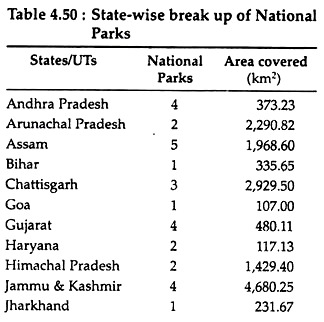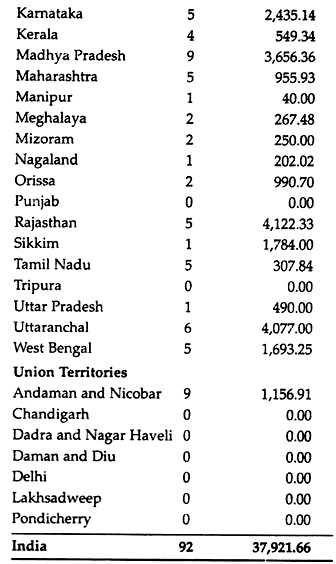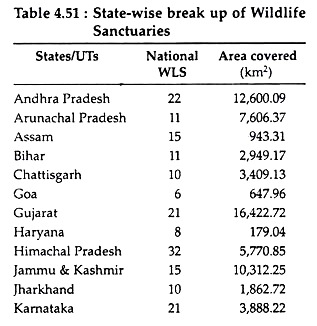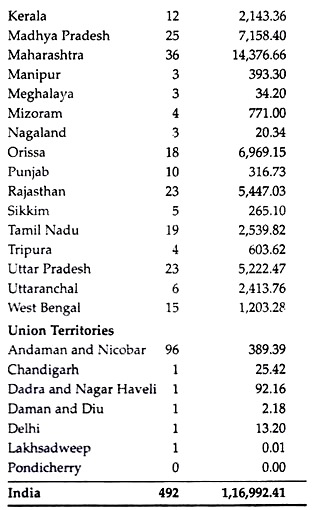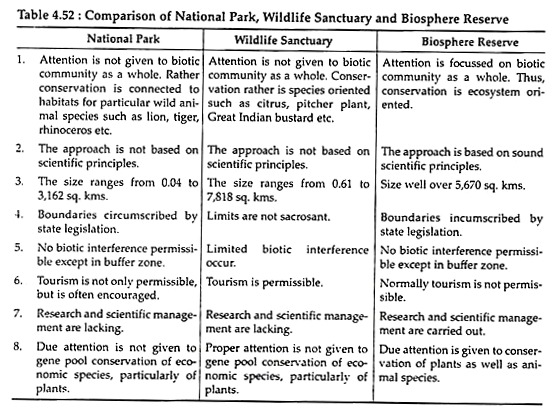List of top three categories of protected areas for conserving wildlife:- 1. Biosphere Reserve 2. National Park 3. Sanctuary.
1. Biosphere Reserve:
Biosphere reserves are undisturbed natural area dedicated to conservation of biological diversity and genetic integrity of animals, plants and microorganisms in their totality. These areas have been set aside for ecological research and habitat preservation and any sort of disturbance is under control. Biosphere Reserve Network Programme was launched by UNESCO in 1971 under its Man and Biosphere (MAB) programme.
The objectives of this programme are:
1. To conserve the representative samples of ecosystems.
ADVERTISEMENTS:
2. To provide long-term in-situ conservation of genetic diversity.
3. Promote natural areas for basic and applied research in ecology and environmental biology.
4. To provide opportunities for environmental education and training.
5. To promote appropriate sustainable managements of the living resources.
ADVERTISEMENTS:
6. To apply the knowledge for promoting sustainable development elsewhere.
7. To promote international cooperation.
A protected area that can be declared as a biosphere should satisfy the following essential criteria:
1. Should occur in each of the 193 bio-geographical regions or provinces of the world as distinguished in the classification of Udvardy (1975), so as to exhibit the maximum genetic diversity.
ADVERTISEMENTS:
2. The proposed biosphere reserve should be unique in itself.
3. It should contain abundant genetic diversity.
4. Structure and size should ensure the efficient conservation of the desired ecosystems and should not lead to genetic drift in future.
5. Each biosphere reserve should be natural home of endangered species of plants and animals.
6. Should have sufficient resources available for ecological education, training and research to be carried on in respect to conservation of nature.
7. If possible should have geographic continuity with other types of protected areas and should have adequate long-term legal protection.
India’s first biosphere reserve was Nilgiri declared in September 1986, located in the Western Ghats. It covers an area of 5,670 km2 and covers states such as Tamil Nadu, Kerala and Karnataka (Table 4.40). It comprises of famous forest areas such as Silent Valley and Western Ghats and has 20 different tribal groups living in it.
Nilgiri is very rich in biological species with almost all important groups of terrestrial and freshwater species existing in it. In India, 14 biosphere reserves has been identified and declared from time to time. The last one being Achanakamar: Amarkantak, declared in 2005 (Table 4.40).
Structure of biosphere reserve:
ADVERTISEMENTS:
Biosphere Reserves basically contain two zones – Core zone and Buffer zone. The buffer zone is the outermost and covers the core zone. The core zone contains specific habitats which is to be conserved in its original form and, therefore, to be protected. The core zone is open strictly for only scientists, research workers and conservation authorities. The buffer zone bears the inevitable human stress and is also open for researchers, scientists etc.
From the purpose of management, biosphere reserve can be divided into:
1. Core zone:
It represents the natural and minimal disturbed ecosystem and in this zone the entry of human being is strictly prohibited.
2. Manipulation (Forestry) zone:
In this zone selected trees can be cut and in their place replacement is essential.
3. Manipulation (Tourism) zone:
Tourists are allowed in this zone to observe the wildlife for education and training.
4. Manipulation (Agriculture) zone:
This zone includes tribal settlements and their cultivated lands.
5. Restoration zone:
This zone includes degraded areas which are selected for restoration to natural or near natural conditions.
2. National Park:
IUCN (1975) defined national park as a relatively large area:
(a) Where one or several ecosystems are not materially altered by human exploitation and occupation, where plant and animal species, geomorphological sites and habitats are of special scientific, educative and re-creative interest or which contains a natural landscape of great beauty.
(b) Where the highest competent authority of the country has taken steps to prevent or eliminate as soon as possible exploitation or occupation in the whole area and to enforce effectively the respect of ecological, geomorphological or aesthetic features which have led to its establishment.
(c) Where visitors are allowed to enter, under special conditions, for inspirational, cultural and re-creative purposes. National Parks are thus areas that are dedicated to conserve the environment and the wildlife in it.
In National Parks, strict prohibition is there on all forestry operations and other usages such as grazing of catties. Nonetheless, National Parks are open to general public as certain parts are developed for tourism in such a way that it does not scare or disturb the wild animals.
Examples of a few well-known National Parks are:
(a) Corbett National Park:
It is the first national park of India being constituted in 1935, with an area of 525 sq. kms. It is situated in the districts of Nainital and Garhwal in Uttar Pradesh.
(b) Kanha National Park:
It was established in 1955, situated in Madhya Pradesh, covering an area of 940 sq. kms. and comprising of hilly terrains and streams.
(c) Simplipal National Park:
It is situated in Mayur Bhanj district of Orissa covering an area of 2,750 sq. kms.
(d) Gir National Park:
It is situated in Junagar district of Gujarat covering an area of 1,880 sq. kms.
(e) Kaziranga National Park:
It is situated on the south bank of Brahmaputra River in the district of Sibsagar in Assam. Established in 1926, it consists of an area of 430 sq. kms. of forest grassland and swamps.
Detail lists of the various National Parks in different state/UTs of India are provided in Table 4.50:
Declaration of National Parks:
Whenever it appears to a State Government that an area, whether within a sanctuary or not, is, by reasons of its ecological, faunal, floral, geomorphological or zoological association or importance needed to be constituted as a National Park for the purpose of protecting, propagation or developing wildlife therein or its environment, it may, by notification, declare its intention to constitute such area as a National Park.
The State Government shall publish a notification specifying the limits of the area which shall be comprised within the National Park and declare that the said area shall be a National Park on and from the date as specified in the notification. No alteration of the boundaries shall be made except on a resolution passed by the legislature of the State.
No person shall destroy, exploit or remove any wildlife from a National Park or destroy or damage the habitat of any wild animal, or deprive any wild animal of its habitat within such National Park except under and in accordance with a permit granted by the Chief Wildlife Warden.
No grazing of any livestock shall be permitted within a National Park and no livestock shall be allowed to enter therein except where such livestock is used as a vehicle by a person authorised to enter such National Park.
3. Sanctuary:
A wildlife sanctuary is also dedicated to protect wildlife. However, its conservation is species-oriented and its boundary is not limited by state legislation. Further, in a wildlife sanctuary, killing, hunting or capturing of any species of birds and mammals is prohibited except by or under the control of highest authority in the department responsible for management of the sanctuary.
In a sanctuary, private ownership may be allowed to continue and forestry and other usages permitted to the extent that they do not adversely affect wildlife. The comparison of a sanctuary with that of National Park and Biosphere reserves is given in Table 4.51.
Examples of various sanctuaries in different states/UTs of India are listed in Table 4.51. Some important sanctuaries are:
(a) Jaldapara Wildlife Sanctuary:
It comprises of 65 sq. kms. of grassland and is situated in Jalpaiguri district of West Bengal.
(b) Periyar Wildlife Sanctuary:
This sanctuary is situated in the state of Kerala and has an area of 777 sq. kms. It was established in 1940 around an artificial lake that came into existence when a dam was constructed across the Periyer River.
(c) Bharatpur Bird Sanctuary (Koeldeo Ghana):
Located at Bharatpur (Rajasthan), this bird sanctuary has an area of 29 sq. kms. and harbours indigenous as well as many migratory birds.
(d) Sariska Wildlife Sanctuary:
This sanctuary is one of the most beautiful wildlife sanctuaries located near Alwar in Rajasthan. It has an area of 800 sq. kms., comprising of dense Dohokra and Solar forests.
(e) Dachigam Wildlife Sanctuary:
Established in 1951 in Kashmir, this sanctuary has an area of 89 sq. kms. and is situated at an altitude of 1,846.2 and 3,692.3 metres (Lower and Upper Dachigam).
Declaration of Sanctuary:
The State Government may, by notification, declare its intention to constitute any area—other than an area comprised with any reserve forest or territorial waters—as a sanctuary if it considers that such area is of adequate ecological, faunal, floral, geomorphological, natural or zoological significance, for the purpose of protecting, propagation or developing wildlife or its environment.
No person—other than a public servant on duty or a person who has been permitted by the Chief Wildlife Warden or the authorised officer—can reside within the limits of the sanctuary.
No person shall damage any boundary- mark of a sanctuary, nor shall he or she tease or molest any wild animal or litter the grounds of sanctuary.
No person shall destroy, exploit or remove any wildlife from a sanctuary or destroy or damage the habitat of any wildlife or deprive any wild animal of its habitat within such sanctuary except under and in accordance with permit granted by the Chief Wildlife Warden.
No person shall take, or cause to be taken or grazed, any livestock in a sanctuary without getting it immunized.
